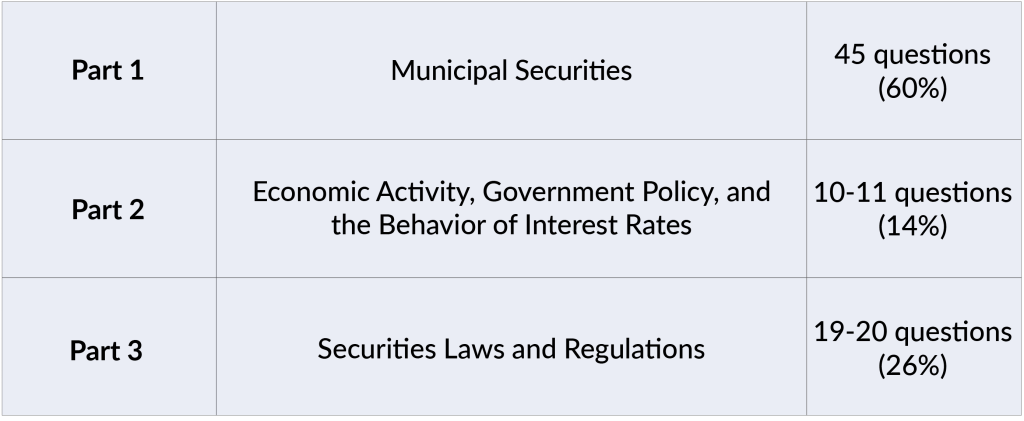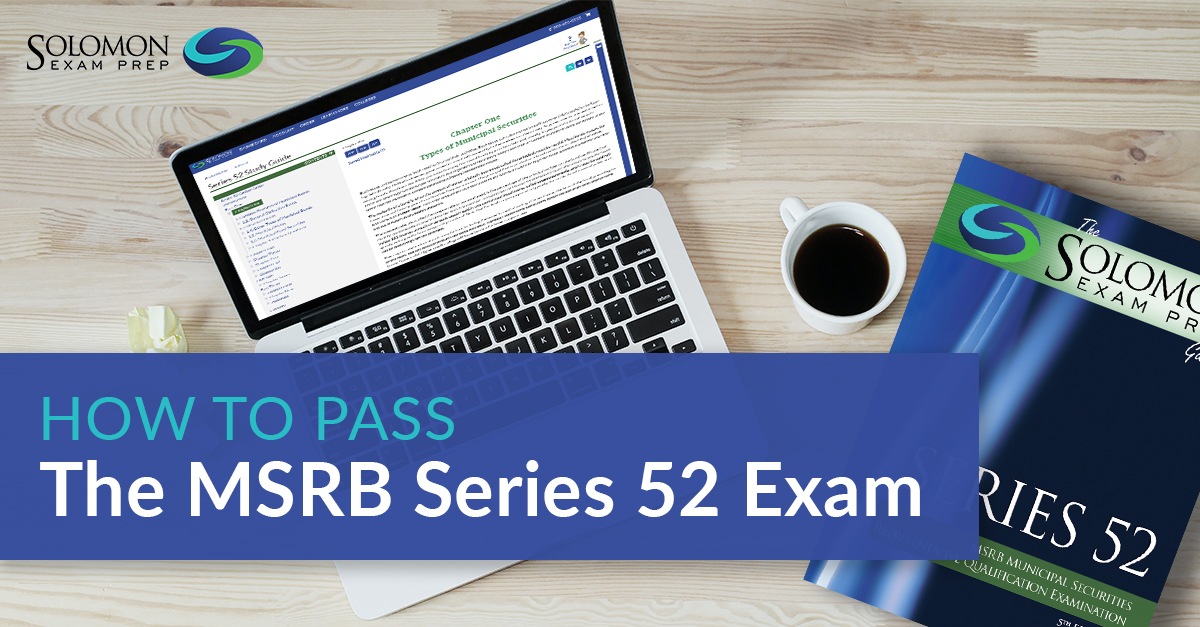What is the Series 52 exam?
If you work for a municipal securities dealer and want to underwrite, trade, and sell municipal securities, then you’ll need to pass the Series 52 exam. You’ll also need to pass the Series 52 exam if you work for a municipal dealer and want to do the following activities:
-
- Offer financial advice and consultant services to issuers of municipal securities
- Conduct research and give investment advice on municipal securities
- Communicate directly or indirectly with public investors about municipal securities
Also known as the Municipal Securities Representative Qualification Examination, the Series 52 was created by the Municipal Securities Rulemaking Board (MSRB). The MSRB is the principal regulator of the municipal securities market. It establishes rules and professional qualification standards for municipal securities dealers and municipal advisors. Those standards include qualification exams for professionals who work in the municipal securities industry. Passing the Series 52 qualifies you to work as a Municipal Securities Representative.
What are municipal securities?
Governments need to finance their activities by raising money, but they can’t sell stocks like businesses. Instead, governments issue municipal bonds (munis) to fund day-to-day operations and special projects.
Are there any prerequisites for the Series 52?
Yes. To become a Municipal Securities Representative, you must also pass the FINRA Securities Industry Essentials (SIE) exam. The SIE is an entry-level securities qualification exam. Unlike the Series 52, you don’t need to be employed and sponsored by a broker-dealer to take the SIE. It’s “co-requisite” with the Series 52, so you can take the exams in any order, but Solomon recommends you take the SIE first. The SIE is a foundational exam, and the knowledge you learn studying for the SIE will help you when you study for the Series 52.
About the Exam
The Series 52 exam consists of 75 scored and five unscored multiple-choice questions covering the three topic areas of the MSRB Series 52 Content Outline. The five additional unscored questions are ones that the exam committee is trying out. These are unidentified and are distributed randomly throughout the exam.

Note: Scores are rounded down to the next lowest whole number (e.g. 69.9% would be a final score of 69% – not a passing score for the Series 52 exam).
Topics Covered on the Exam
The MSRB divides the questions on the Series 52 exam into three main areas:

Within these three main parts, you’ll need to learn about many topics, including:
-
- Municipal bonds
- Municipal fund securities
- MSRB rules
- Customer accounts
- Municipal securities trading
- Recordkeeping
- Suitability
- Settlement and delivery
- Taxation
- Federal securities acts
- The SEC
- Municipal securities underwriting
- Marketability
- Political contribution rules
- Supervisory obligations
- Market indicators
- Economic theory
- Fiscal and monetary policy
- Interest rates
- Business cycles
- The Federal Reserve Board
The MSRB updates its exam questions regularly to reflect the most current rules and regulations. Solomon recommends that you print out the current version of the MSRB Series 52 Content Outline and use it in conjunction with the Solomon Series 52 Study Guide. The Content Outline is subject to change without notice, so make sure you have the most recent version.
Question Types on the Exam
The Series 52 exam consists of multiple-choice questions, each with four options. You will see these question structures:
Closed Stem Format:
This item type asks a question and gives four possible answers to choose from.
Which of the following is a reason that a municipal government might issue a revenue bond instead of a general obligation bond?
-
- The issuer wishes to pay less interest to the bondholders.
- The issuer has met its statutory debt limit and does not want to seek voter approval for the issue.
- The issuer wants the bond to have a higher credit rating.
- The issuer has the ability to impose taxes.
Incomplete Sentence Format:
This kind of question has an incomplete sentence followed by four possible conclusions.
A make whole call provision is a provision in a bond that allows the issuer to:
-
- Call the bond and pay the bondholder a lump sum payment that includes not just the principal but also the net present value of all future coupon payments that the bondholder would have received if not for the call.
- Call the bond and pay the bondholder a lump sum payment that includes the call price of the bond.
- Redeem the entire issue early to issue a new set of bonds at a lower interest rate.
- Call the bond when the total amount of the interest payments is equivalent to the amount of the principal.
“EXCEPT” Format:
This type requires you to recognize the one choice that is an exception among the four answer choices.
A financial advisor may buy securities from an underwriter for its own or its customers’ accounts if all of the following are true except:
-
- The advisor must not receive any additional underwriting compensation when buying securities for their own account.
- The advisor must not receive any additional underwriting compensation when buying securities for customer accounts.
- The advisor must disclose the conflict of interest to their customers at or before confirmation of the sale.
- The advisor must disclose the conflict of interest to the issuer.
Complex Multiple-Choice (“Roman Numeral”) Format:
For this question type, you see a question followed by two or more statements identified by Roman numerals. The four answer choices represent combinations of these statements. You must select the combination that best answers the question.
_________ risk is a concern for bondholders when interest rates _________.
-
- Interest rate; rise
- Call; rise
- Interest rate; fall
- Call; fall
-
- II and IV
- II and III
- I and IV
- I and III
Answers: 1. B 2. A 3. D 4. C
For an even better idea of the possible question types you might encounter on the Series 52 exam, try Solomon Exam Prep’s free Series 52 Sample Quiz.
Taking the Series 52 Exam
The Financial Industry Regulatory Authority (FINRA) administers the Series 52 exam, and you must take it at a Prometric test center. Like all qualifying exams in the securities industry, the Series 52 is closed-book, and you’re not allowed to bring anything into the exam. The test center will provide you with any materials you need to complete the exam. For instance, the test center will likely provide a whiteboard with markers or scratch paper and a pencil, as well as a basic electronic calculator. The inspection and sign-in requirements at test centers are stringent, so plan to arrive at least 30 minutes before your scheduled test appointment.
Test-Taking Tips
When taking the exam, it helps to keep some test-taking strategies in mind. Try not to spend too long on one question—this may cause you to run out of time and not get to other questions you know. If you don’t know the answer to a question, guess at the answer and “flag” it. There’s no penalty for guessing, so it’s beneficial to answer every question.
After you’ve finished all the questions, you can come back to any flagged questions. This strategy allows you to efficiently answer the ones you know. You might also learn something later in the exam that helps you answer an earlier question. Just remember to save enough time to return to the questions you didn’t answer. However, it’s not a good idea to simply skip all of the difficult questions with the plan to answer them later. You should make a serious effort to answer each question before moving on to the next one since your thoughts are often clearer earlier on during the exam.
How to Study for the Series 52 Exam
Follow Solomon Exam Prep’s proven study system:
-
- Read and understand. Read the Solomon Study Guide, carefully. Many students read the Study Guide two or three times before taking the exam. To increase your ability to focus while reading, or as an alternative to reading, the Solomon Series 52 Audiobook will be launching soon! The Audiobook is a word-for-word reading of the Study Guide.
- Answer practice questions in the Exam Simulator. When you finish reading a chapter in the Study Guide, take 4–6 chapter quizzes in the Exam Simulator. Use these quizzes to give yourself practice and to find out what you need to study more. Make sure you read and understand the question rationales. When you’re finished reading the entire Study Guide, review your handwritten notes once more. Finally, start taking full practice exams in the Exam Simulator. Aim to pass at least six full practice exams and try to get your average score to at least 80%. When you reach that point, you’re probably ready to sit for the Series 52 exam.
Use these effective study strategies:
-
- Take handwritten notes. As you read the Study Guide, take handwritten notes and review your notes every day for 10–15 minutes. Studies show that taking handwritten notes in your own words and then reviewing them strengthens learning and memory.
- Make flashcards. Making your own flashcards is another proven method to reinforce memory and strengthen learning.
- Research. Research anything you don’t understand. Curiosity = learning. Students who take responsibility for their own learning by researching anything they don’t understand get a deeper understanding of the subject matter and are much more likely to pass.
- Become the teacher. Studies show that explaining what you’re learning greatly increases your understanding of the material. Ask someone in your life to listen and ask questions, or explain it out loud to yourself. Studies show this helps almost as much as explaining to an actual person (see Solomon’s previous blog post to learn more about this strategy!).
Take advantage of Solomon’s supplemental tools and resources:
-
- Use all the resources. The Series 52 Resources folder in your Solomon student account has helpful study tools, including documents that summarize important exam concepts. There’s also a detailed study schedule that you can print out – or use the online study schedule and check off tasks as you complete them.
- Use Ask the Professor. If you have a content-related question, click the Ask the Professor button in your account dashboard and get personalized help from a Solomon professor.
-
Good practices while studying:
- Take regular breaks. Studies show that if you’re studying for an exam, taking regular walks in a park or natural setting significantly improves scores. Walks in urban areas or among people did not improve test scores.
- Get enough sleep during the period when you are studying. Sleep consolidates learning into memory, studies show. Be good to yourself while you’re studying for the Series 52: exercise, eat well, and avoid activities that will hurt your ability to get a good night’s sleep.
You can pass the MSRB Series 52 Exam! It just takes focus and determination. Solomon Exam Prep is here to support you on your path to becoming a municipal securities representative!
Explore all Solomon Exam Prep Series 52 study materials, including the Study Guide and Exam Simulator.
And join the Solomon email list to find out when the Series 52 Audiobook is released! Just click the button below:

